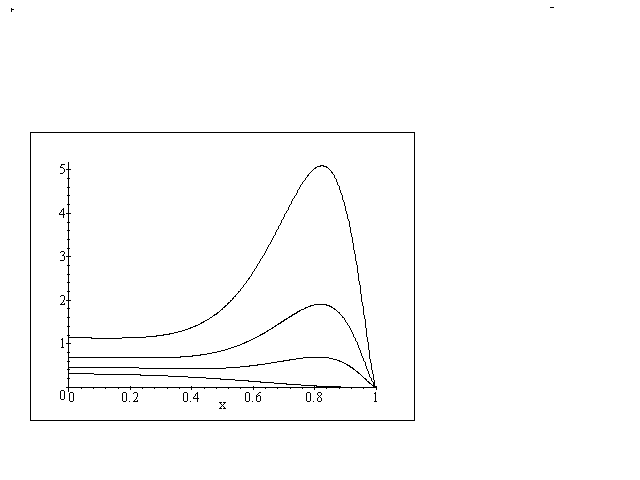 Recent technological progress in fabrication of semiconducting and metallic nanostructures opened a vast field of research of their electron properties
[1,
2].
Traditionally application of high magnetic fields is an extremely powerful method for experimental studies of electronic properties in solids. Detailed theoretical study of the electron spectrum of the nano-structures under strong magnetic fields is therefore of primary importance for the future progress in this field . Initially the solutions for an electron in confined plane geometries, like a disc, ring, cylinder and oval shape stadium
[3,
4,
5]
were proposed. As it was shown in
[5]
, these models are relevant to the notion of the chaos in the level statistics and related thermodynamics of such systems. Among already studied three dimensional systems are electrons on simple surfaces as nanotubes
[5,
6,
7].
A challenging problem is an adequate quantum mechanical description of noninteracting electrons on a nanoparticle of an arbitrary shape.
Recent technological progress in fabrication of semiconducting and metallic nanostructures opened a vast field of research of their electron properties
[1,
2].
Traditionally application of high magnetic fields is an extremely powerful method for experimental studies of electronic properties in solids. Detailed theoretical study of the electron spectrum of the nano-structures under strong magnetic fields is therefore of primary importance for the future progress in this field . Initially the solutions for an electron in confined plane geometries, like a disc, ring, cylinder and oval shape stadium
[3,
4,
5]
were proposed. As it was shown in
[5]
, these models are relevant to the notion of the chaos in the level statistics and related thermodynamics of such systems. Among already studied three dimensional systems are electrons on simple surfaces as nanotubes
[5,
6,
7].
A challenging problem is an adequate quantum mechanical description of noninteracting electrons on a nanoparticle of an arbitrary shape.  Here we consider a single electron confined to the surface of revolution placed in an axial uniform magnetic field . Our goal is to treat the general case of the arbitrary shaped surface of revolution
Here we consider a single electron confined to the surface of revolution placed in an axial uniform magnetic field . Our goal is to treat the general case of the arbitrary shaped surface of revolution  (
(  are cylindrical coordinates) and to investigate influence of its geometrical characteristics upon quantum- mechanical spectrum. Further we suppose the surface to be smooth , closed and crossing
are cylindrical coordinates) and to investigate influence of its geometrical characteristics upon quantum- mechanical spectrum. Further we suppose the surface to be smooth , closed and crossing  -axes only in two points. The uniform magnetic field
-axes only in two points. The uniform magnetic field  is defined to point in the
is defined to point in the  -direction .
-direction .  The problem is described by the Hamiltonian
The problem is described by the Hamiltonian 
  | (1) |
 is the symmetric gauge ,
is the symmetric gauge ,  are Cartesian coordinates. This is leading to the Schrodinger equation on the surface
are Cartesian coordinates. This is leading to the Schrodinger equation on the surface 

|

|

|
(2) |
 ,
, 

 .
.  We introduce new orthogonal coordinates by
We introduce new orthogonal coordinates by  , where the function
, where the function  maps conformally the domain of the
maps conformally the domain of the  -plane containing the unit circle onto the domain of the
-plane containing the unit circle onto the domain of the  -plane containing the closed curve
-plane containing the closed curve  This curve is the image of the circle
This curve is the image of the circle  with the arc
with the arc 

 corresponding to
corresponding to  . Since conformal mapping conserves a normal to the surface, it enables us to write the Eq.
2
on the surface
. Since conformal mapping conserves a normal to the surface, it enables us to write the Eq.
2
on the surface  neglecting derivatives in
neglecting derivatives in  Thus , the three dimensional Schrodinger operator has been reduced to a two-dimensional operator in
Thus , the three dimensional Schrodinger operator has been reduced to a two-dimensional operator in  -variables .
-variables .  Due to conservation of the
Due to conservation of the  -component of the angular momentum, the cyclic coordinate
-component of the angular momentum, the cyclic coordinate  can be separated in the Fourier series development
can be separated in the Fourier series development 
  | (3) |

 results in the ordinary differential equation of the second order
results in the ordinary differential equation of the second order
 | (4) |
 Here :
Here :  ,
, 
 ,
, 





 ,
,  ,
,  ,
,  .
.  A low field
A low field  asymptotics of the spectrum and eigenfunctions may be found in the traditional way by the pertubation method . It is much more difficult to suggest some general approach to indicate a high field
asymptotics of the spectrum and eigenfunctions may be found in the traditional way by the pertubation method . It is much more difficult to suggest some general approach to indicate a high field  asymptotics. This is governed by coefficients of the Eq.
4
or , in other words , by the surface shape. Some possible shapes and corresponding conformal mappings
asymptotics. This is governed by coefficients of the Eq.
4
or , in other words , by the surface shape. Some possible shapes and corresponding conformal mappings  are shown on Fig 1-10.,where conformal mappings are pointed out in the brackets.
are shown on Fig 1-10.,where conformal mappings are pointed out in the brackets.
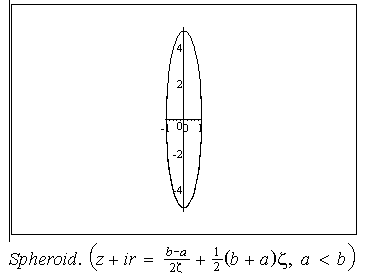
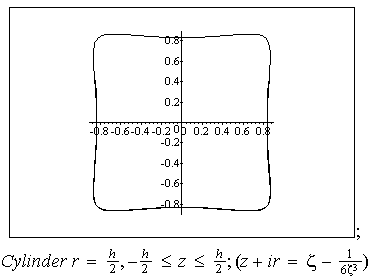

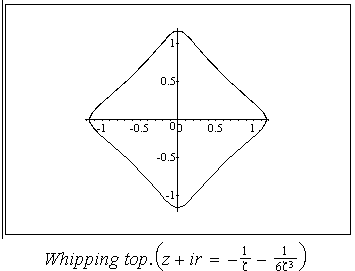

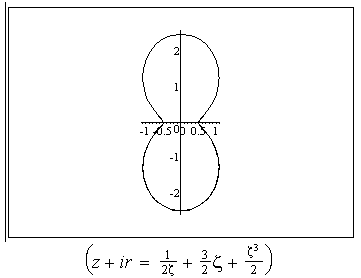
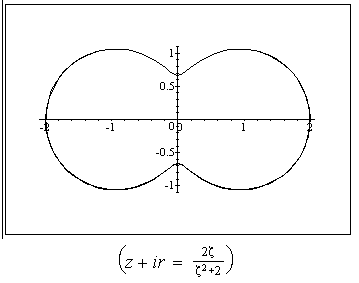
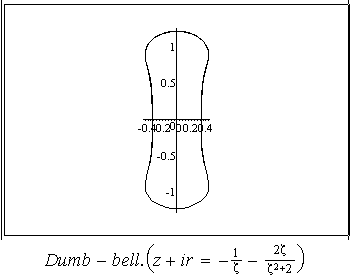
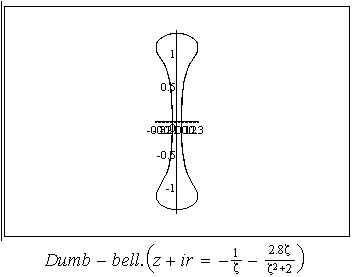
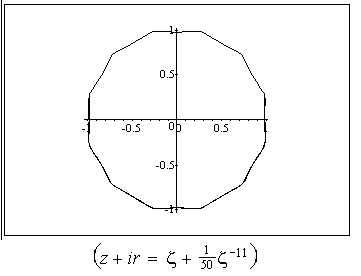
 .
.  Below we consider closely a spheroidal surface whose equation is
Below we consider closely a spheroidal surface whose equation is 
  | (5) |



 is an one-to-one mapping of the unit circle
is an one-to-one mapping of the unit circle  onto this ellipse of the
onto this ellipse of the  -plane .
-plane .  The Eq.
4
can be written in the form
The Eq.
4
can be written in the form 
  | (6) |

 . Its eigenfunctions
. Its eigenfunctions  have
have  zeroes in the interval
zeroes in the interval  . One can see, that if
. One can see, that if  is even (odd) integer, then these functions are even (odd) .
is even (odd) integer, then these functions are even (odd) .  It can be shown that all eigenvalues
It can be shown that all eigenvalues  are positive . They are large as one of the conditions : 1)
are positive . They are large as one of the conditions : 1)  , 2)
, 2)  , 3)
, 3)  , is fulfilled . Below we are pointing out leading terms of the corresponding asymptotics .
, is fulfilled . Below we are pointing out leading terms of the corresponding asymptotics .  As
As  , the spectrum can be obtained with the method of the paper [
8
]. Particularly , the leading term is given by
, the spectrum can be obtained with the method of the paper [
8
]. Particularly , the leading term is given by 
  | (7) |
 is a complete elliptic integral of the second kind .
is a complete elliptic integral of the second kind .  As
As  , the asymptotic expansion may be found with a stretched variable
, the asymptotic expansion may be found with a stretched variable  .Eigenfunctions are expressed by Hermite polynomials
.Eigenfunctions are expressed by Hermite polynomials  ,
, 
 In the high field limit (
In the high field limit (  ) the spectrum is given by an asymptotic formula:
) the spectrum is given by an asymptotic formula: (8)
 The corresponding asymptotic expansion of the eigenfunctions is expressed by Laguere polynomials
The corresponding asymptotic expansion of the eigenfunctions is expressed by Laguere polynomials 

 Their leading term is irrespective of a spheroidal geometry and coincide with the spectrum for the plane. The energy level corresponds to two quasi-degenerated bound states labeled
Their leading term is irrespective of a spheroidal geometry and coincide with the spectrum for the plane. The energy level corresponds to two quasi-degenerated bound states labeled  and
and 
 A disk of the radius
A disk of the radius  is a limiting case of a strongly flattened spheroidal shell (
is a limiting case of a strongly flattened spheroidal shell ( ). In this limit , the values of the eigenfunctions on both sides of the disk
). In this limit , the values of the eigenfunctions on both sides of the disk  are added and according to the above formula the antisymmetric eigenfunctions are cancelled out . Since
are added and according to the above formula the antisymmetric eigenfunctions are cancelled out . Since  , we obtain
, we obtain 

  | (9) |

 . In the high magnetic field the disc (circle billiard) spectrum coalesces into the straight lines nearly the same that in the classical Landau problem . This confirms results of the numerical calculations by K.Nakamura and H.Thomas [
5
].
. In the high magnetic field the disc (circle billiard) spectrum coalesces into the straight lines nearly the same that in the classical Landau problem . This confirms results of the numerical calculations by K.Nakamura and H.Thomas [
5
].  In order to calculate the spectrum we represent
In order to calculate the spectrum we represent  by the expression
by the expression  ,
,  Here indices
Here indices  are either even or odd integers corresponding to the to symmetric and antisymmetric solutions , respectively.
are either even or odd integers corresponding to the to symmetric and antisymmetric solutions , respectively.  Substituting this expansion into the Eq.
6
yields two recurrence formulas (separately for even and odd integers
Substituting this expansion into the Eq.
6
yields two recurrence formulas (separately for even and odd integers  )
) 
  | (10) |




 . These continued fractions are real because
. These continued fractions are real because  are real values.
are real values.  Results of the calculations are represented on the Fig 11-14.
Results of the calculations are represented on the Fig 11-14.

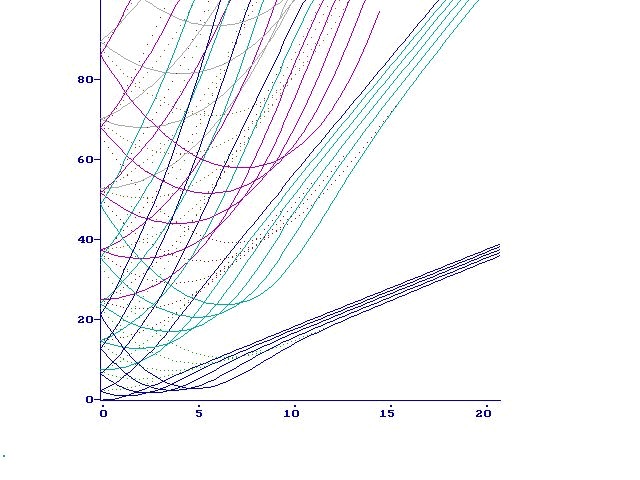



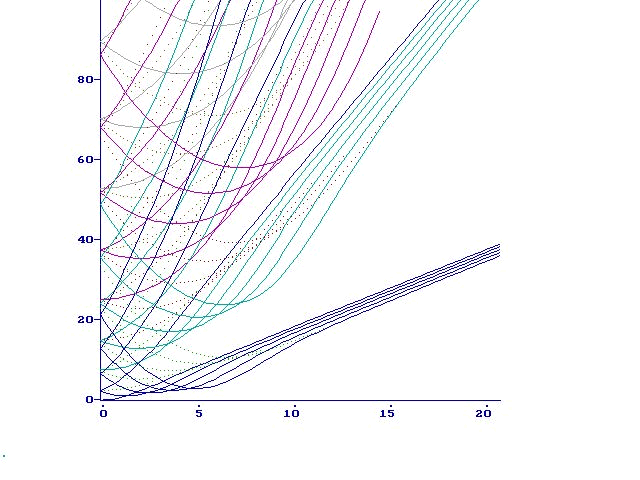

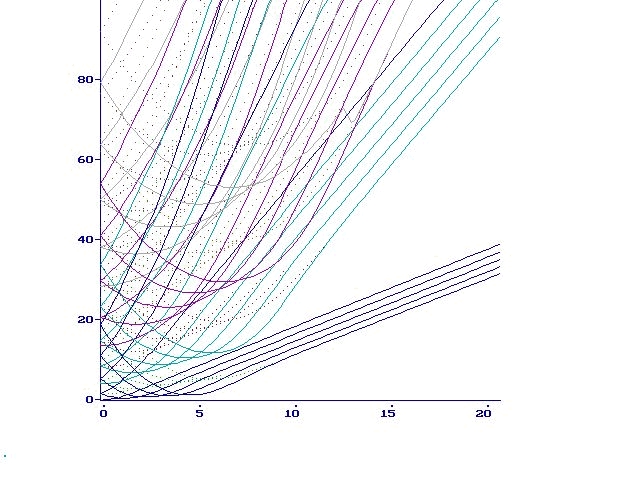

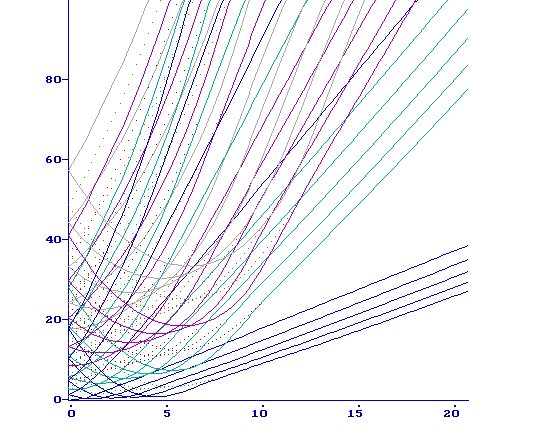

 or
or  increase, the distance between lines of the same bunch( the splitted Landau level) enlarges. Irregular crossings intensify as well. These crossings arise from dropping and intermingling lines of the different bunches.
increase, the distance between lines of the same bunch( the splitted Landau level) enlarges. Irregular crossings intensify as well. These crossings arise from dropping and intermingling lines of the different bunches. 